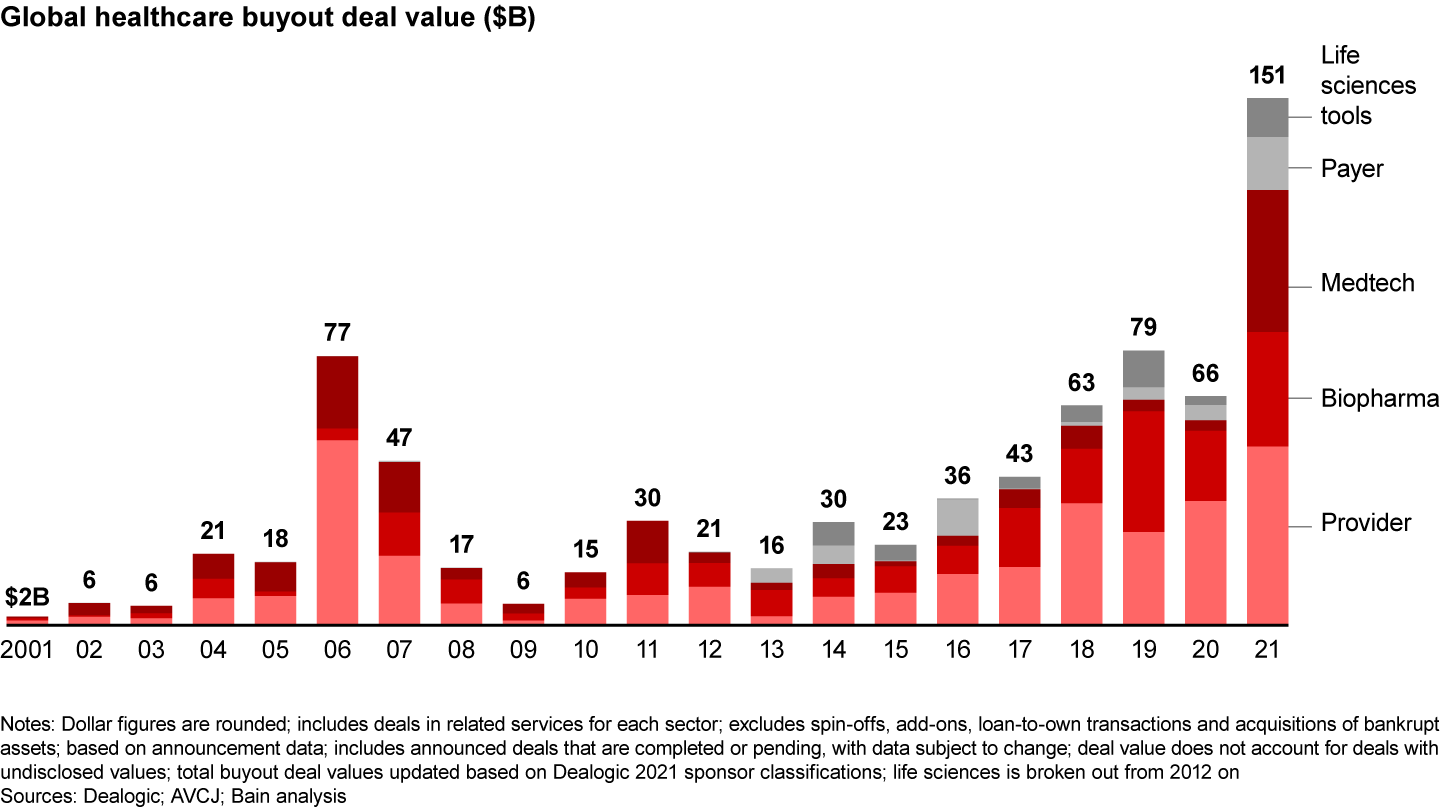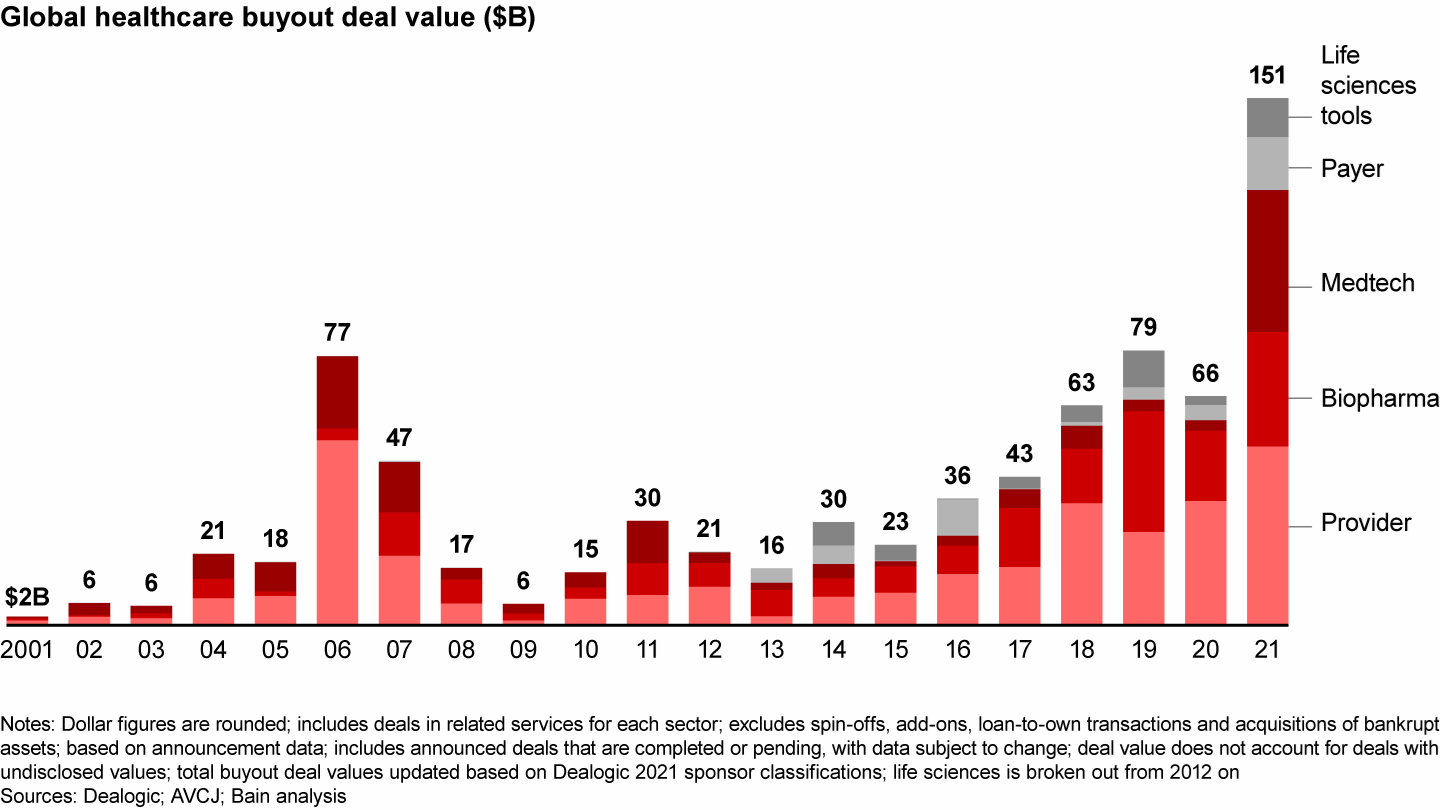Report

At a Glance
- Investors completed 96 medtech deals in 2021, up sharply from 55 in 2020 and surpassing the previous high of 60 in 2018.
- This increase was fueled by Asia-Pacific transactions, which accounted for 45% of global deals, the largest share, as investors targeted local manufacturers.
- Deal value surged to $40.8 billion from $3 billion in 2020, largely reflecting the Medline deal valued at $34 billion. Such swings typify the sector, where large assets are relatively scarce.
- Major themes for North American and European investors include supply chain resilience and cost containment, technology for alternative care, specialty contract manufacturing, and regulatory support.
This article is part of Bain's 2022 Global Healthcare Private Equity and M&A Report
The Covid-19 pandemic, for all its havoc, has highlighted opportunities in the medical technology sector, particularly involving supply chain vulnerabilities. For the second straight year, the sector’s deal volume surged.
In 2021, new investment themes emerged, with sponsors focusing on services rather than products. This shift highlights emerging priorities of original equipment manufacturers (OEMs) and end customers. In 2021, investors sharpened their focus on companies that help reduce overall healthcare costs, including several companies that engage in remote monitoring, white-label equipment, and chronic disease treatment. But competition from corporate acquirers, along with longer innovation cycles, means the number of truly attractive assets is relatively low.
The number of deals rose to 96 from 55 in 2020, and disclosed value almost doubled, even excluding the $34 billion Medline deal (see Figure 1). The year had 4 transactions of $1 billion or more, the highest count to date.


Five investment themes infused the deal flow in 2021:
- supply chain products and services to reliably deliver care;
- technology that enables care delivery in lower-cost sites;
- heightened interest in specialty contract manufacturing organizations (CMOs) with niche capabilities;
- more activity in regulatory support services; and
- more transactions in the Asia-Pacific region.
Let’s review each in turn.
Supply chain resilience for medical equipment and supplies
Covid-19 put healthcare systems under extreme pressure and exposed vulnerabilities in their supply chains. In turn, healthcare companies have sought providers adept in logistics and infrastructure to reliably and cost-effectively supply essential tools and equipment. The standout investment in this area was the largest buyout of the year, Medline, executed by consortium of Blackstone, Carlyle, Hellman & Friedman, GIC, and ADIA. Medline has a robust private-label portfolio and distribution network that provides product and distribution savings for the entire healthcare continuum. Its end-to-end control of the value chain, from manufacturing through fulfillment, provides an additional layer of supply chain resiliency for customers.
Other notable investments in the physical infrastructure for distribution equipment include Platinum Equity’s acquisition of NDC, an intermediary between manufacturer and small or regional providers, and Flexpoint Ford’s acquisition of Canadian Hospital Specialties, a distributor and manufacturer of surgical products.
Besides physical infrastructure, digital supply chain and distribution infrastructure for providers attracted private equity. Warburg Pincus made a growth investment in Global Healthcare Exchange, a cloud-based trading network and supply chain automation software as a service for healthcare products.
Extending this attention to supply chains, healthcare companies are also trying to reduce costs related to equipment maintenance, repair, and refurbishment, spurring deals of providers in this area. PartsSource, for instance, helps customers reduce costs by selling replacement parts, reducing the total cost of ownership for expensive medical equipment, and extending the useful life of medical equipment to help reduce overall hospital costs. We expect this to be a continued theme of investments as hospitals continue to feel pressure to reduce costs.
Support for patient care at alternative sites
As providers and payers continue to reinvent care delivery, medtech companies play a large role in supporting a shift to home-based care. This has created investment opportunities in remote monitoring. Key deals include Water Street’s growth investment in Medical Guardian, a remote monitoring and emergency alert device, and Rockbridge-backed Connect America’s acquisition of 100Plus, a remote monitoring device company.
Alternative-site and remote care have also increased demand for direct-to-consumer medical devices that remotely monitor patients and keep them in the outpatient setting, lowering hospital admissions and, ideally, overall healthcare costs. Two examples of such growth investments are Beecken Petty O’Keefe’s investment in Home Care Delivered, a direct-to-patient provider of reimbursed medical supplies, and Advanced Diabetes’s purchase of US Medical Supply, a supplier of glucose monitors for diabetes.
The rise of specialty CMOs
In Europe and North America, activity increased in CMOs and contract development and manufacturing organizations (CDMOs). However, acquisitions have shifted to target assets with specialized manufacturing capabilities focused on high-growth areas, including minimally invasive surgery, cardiac devices, and neurological devices. Niche CMOs and CDMOs are typically insulated from pricing pressure due to their unique applications and differentiated capabilities. In addition, the ability to manufacture micro or precision components, which OEMs typically don’t have, makes CMOs with specialized manufacturing capabilities attractive. Buyouts included Altaris’s investment in Minnetronix, the Canadian Pension Fund’s $1.2 billion investment stake in CeramTec, and Carlyle’s acquisition of a 50% stake of Resonetics, a leader in micro manufacturing.
Help in navigating regulation
The prospect of more stringent regulatory requirements in the US, similar to those in Europe, is leading investors to explore companies that provide regulatory support services, such as compliance consulting and life cycle management. That logic underpins Linden Capital Partners’ investment in RQM+ and JMI Equity’s investment in Greenlight Guru. In another notable deal, Sverica Capital Management-backed Gener8 acquired RND, a provider of software development services focused on medical devices, including assessing compliance and verifying design outputs for US Food and Drug Administration approval.
A surge in Asia-Pacific
As the Asia-Pacific private equity market continues to mature, medtech activity has surged, particularly in China, fueled by governmental incentives and attractive assets. The region’s medtech deals increased to 43 from 26 in 2020. The rise was propelled by China’s 34 deals, up from 23 in 2020 and just 7 in 2019. Cardiac medical devices were a particularly active investment area in China, including investments in NewMed Medical, MagAssist, and Hanyu Medical.
Structural drivers of demand show no signs of letting up
Looking ahead, we expect pockets of the sector to continue attracting sponsors, although heightened corporate competition will reduce the number of viable opportunities. Cost pressures will continue to weigh on providers’ income statements, reinforcing the value of equipment maintenance and repair specialists. Additionally, as doctors continue to seek innovative technology to deliver better care, specialty CDMOs and firms in preclinical, commercialization, and regulatory support will all warrant investor interest.